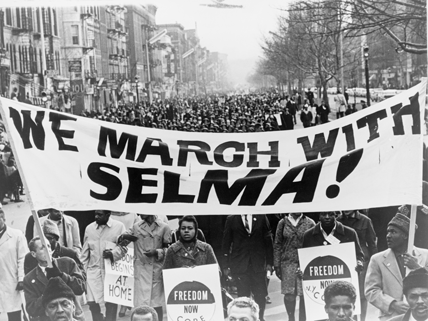
In Harlem in 1965, an estimated 15,000 New Yorkers march in solidarity with the protesters in Selma.
A key event of the 1960s civil rights movement has been commemorated both on the ground and in cinema. On March 7, 1965, about 600 civil rights supporters gathered in Selma, Alabama, intending to march to the state capital, Montgomery, to protest against widespread violations of African Americans’ constitutional right to vote. The group was met by a force of white state and local police, who blocked passage and inflicted beatings on many of the demonstrators. The event became known as Bloody Sunday. News and film footage of the police brutality reached every corner of the nation, helping lead to passage of the Voting Rights Act of 1965.
The Voting Rights Act was aimed at eliminating every means of discrimination that undermined the ability of African Americans and other minorities to exercise their right to vote—from poll taxes, to literacy and civics tests, to various other requirements. For examples, new voters had to be “vouched for” by an existing voter, and the names and addresses of newly registered voters were published in the newspaper. These practices enabled intimidation tactics. Such measures had been used by state governments, especially in the South, and particularly in Alabama, for decades to disenfranchise black Americans. In Selma, which in the 1960s had a population that was 60 percent African American, only 3 percent of registered voters were black.
In 2015, a reenactment of the march—minus the brutal opposition—was held in Selma, attended by tens of thousands of Americans, including President Barack Obama and his family. In the months prior to the 50th anniversary of the march, the history surrounding Bloody Sunday was reintroduced to Americans via the feature film Selma, directed by Ava DuVernay and starring David Oyelowo as Martin Luther King Jr. (Although King was not present on Bloody Sunday, he soon would lead a successful march to Montgomery.) The film has been widely acclaimed, despite some controversy over historical accuracy, especially regarding the role of President Lyndon Johnson.
Image credit: © Library of Congress, Prints and Photographs Division
Related Links
- Selma’s “Bloody Sunday,” 50 Years Ago
This article takes you back to the events surrounding Bloody Sunday in Selma, Alabama.
(Source: HISTORY.com; accessed March 23, 2015) - Thousands March on Selma, Alabama Bridge to Mark “Bloody Sunday”
This article covers the commemorative march in Selma on March 7, 2015.
(Source: Reuters, March 8, 2015) - Selma to Montgomery: 50 Years Later
The White House created a website devoted to the historic march; includes history, images, audio recordings of many participants; and a video of President Obama’s speech at the reenactment.
(Source: whitehouse.gov; accessed March 20, 2015) - Selma: MLK in Masterful Microcosm
A positive review of the film Selma.
(Source: The Atlantic, December 26, 2014) - The Movie “Selma” Has a Glaring Flaw
This review points out historical inaccuracies in the film Selma; includes links to original recorded conversations between King and Johnson and other reports at the LBJ Presidential Library.
(Source: Washington Post; December 26, 2014) - Selma-to-Montgomery March: National Historic Trail and All-American Road
Visit the National Park Service website to read about the significance of the historic Selma marches, the route of which is now preserved as a National Historic Trail.
(Source: nps.gov; accessed March 20, 2015)



